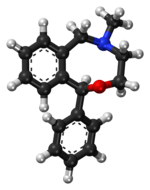Nefopam
Nefopam, sold under the brand names Acupan and nefopam medisol among others, is a painkilling medication. It is primarily used to treat moderate to severe, acute or chronic pain.[3]
 | |
 | |
| Clinical data | |
|---|---|
| Trade names | néfopam medisol |
| AHFS/Drugs.com | International Drug Names |
| Routes of administration | Oral, intramuscular, intravenous |
| ATC code | |
| Legal status | |
| Legal status |
|
| Pharmacokinetic data | |
| Bioavailability | Low[1] |
| Protein binding | 70–75% (mean 73%)[1][2] |
| Metabolism | Liver (N-demethylation, others)[1] |
| Metabolites | Desmethylnefopam, others[1] |
| Elimination half-life | Nefopam: 3–8 hours[1] Desmethylnefopam: 10–15 hours[1] |
| Excretion | Urine: 79.3%[1] Feces: 13.4%[1] |
| Identifiers | |
IUPAC name
| |
| CAS Number | |
| PubChem CID | |
| ChemSpider | |
| UNII | |
| KEGG | |
| ChEBI | |
| CompTox Dashboard (EPA) | |
| ECHA InfoCard | 100.033.757 |
| Chemical and physical data | |
| Formula | C17H19NO |
| Molar mass | 253.34 g/mol g·mol−1 |
| 3D model (JSmol) | |
SMILES
| |
InChI
| |
| | |
It is believed to work in the brain and spinal cord to relieve pain. There it is believed to work via unique mechanisms. Firstly it increases the activity of the serotonin, norepinephrine and dopamine neurotransmitters involved in, among other things, pain signaling. Secondly, it modulates sodium and calcium channels, thereby inhibiting the release of glutamate, a key neurotransmitter involved in pain processing.[4]
Medical uses
Nefopam is effective for prevention of shivering during surgery or recovery from surgery.[5][6] Nefopam was significantly more effective than aspirin as an analgesic in one clinical trial,[7] although with a greater incidence of side effects such as sweating, dizziness and nausea, especially at higher doses.[8][9] The estimated relative potency of nefopam to morphine indicates that 20 mg of nefopam HCl is the approximate analgesic equal of 12 mg of morphine with comparable analgesic efficacy to morphine,[10][11][12] or oxycodone,[13] while Nefopam tends to produce fewer side effects, does not produce respiratory depression,[14] and has much less abuse potential, and so is useful either as an alternative to opioids, or as an adjunctive treatment for use alongside opioid(s) or other analgesics.[12][15] Nefopam is also used to treat severe hiccups.[16]
Desmoid tumors
Nefopam is being studied as a treatment for the desmoid tumors associated with aggressive fibromatosis.[17] Nefopam has been shown to slow or stop desmoid tumors' growth in mice during a pre-clinical phase study.[18]
Contraindications
Nefopam is contraindicated in people with convulsive disorders, those that have received treatment with irreversible monoamine oxidase inhibitors such as phenelzine, tranylcypromine or isocarboxazid within the past 30 days and those with myocardial infarction pain, mostly due to a lack of safety data in these conditions.[19]
Side effects
Common side effects include nausea, nervousness, dry mouth, light-headedness and urinary retention.[19] Less common side effects include vomiting, blurred vision, drowsiness, sweating, insomnia, headache, confusion, hallucinations, tachycardia, aggravation of angina and rarely a temporary and benign pink discolouration of the skin or erythema multiforme.[19] Overall, the incidence of side-effects are less with the oral formulation and generally transient and mild in nature.
Overdose
Overdose and death have been reported with nefopam,[20] although these events are less common with nefopam than with opioid analgesics.[21] Overdose usually manifests with convulsions, hallucinations, tachycardia, and hyperdynamic circulation.[19] Treatment is usually supportive, managing cardiovascular complications with beta blockers and limiting absorption with activated charcoal.[19]
Interactions
It has additive anticholinergic and sympathomimetic effects with other agents with these properties.[19] Its use should be avoided in people receiving some types of antidepressants (tricyclic antidepressants or monoamine oxidase inhibitors) as there is the potential for serotonin syndrome or hypertensive crises to result.[19]
Pharmacology
| Site | Ki (nM) |
|---|---|
| SERT | 29 |
| NET | 33 |
| DAT | 531 |
| 5-HT2A | 1,685 |
| 5-HT2B | 330 |
| 5-HT2C | 56 |
The mechanism of action of nefopam and its analgesic effects are not well understood, although inhibition of the reuptake of serotonin, norepinephrine, and to a lesser extent dopamine (that is, acting as an SNDRI) is thought to be involved.[24][4] It also reduces glutamate signaling via modulating sodium and calcium channels.[25][4]
Pharmacokinetics
The absolute bioavailability of nefopam is low.[1] It is reported to achieve therapeutic plasma concentrations between 49 and 183 nM.[23] The drug is approximately 73% protein-bound across a plasma range of 7 to 226 ng/mL (28–892 nM).[1] The metabolism of nefopam is hepatic, by N-demethylation and via other routes.[1] Its terminal half-life is 3 to 8 hours, while that of its active metabolite, desmethylnefopam, is 10 to 15 hours.[1] It is eliminated mostly in urine, and to a lesser extent in feces.[1]
Chemistry
Nefopam is a cyclized analogue of orphenadrine, diphenhydramine, and tofenacin, with each of these compounds different from one another only by the presence of one or two carbons.[26][27][28] The ring system of nefopam is a benzoxazocine system.[26][29]
Society and culture
References
- Sanga M, Banach J, Ledvina A, Modi NB, Mittur A (November 2016). "Pharmacokinetics, metabolism, and excretion of nefopam, a dual reuptake inhibitor in healthy male volunteers". Xenobiotica: The Fate of Foreign Compounds in Biological Systems. 46 (11): 1001–16. doi:10.3109/00498254.2015.1136989. PMID 26796604.
- Seyffart G (6 December 2012). Drug Dosage in Renal Insufficiency. Springer Science & Business Media. pp. 407–. ISBN 978-94-011-3804-8.
- Brayfield, A, ed. (27 October 2016). "Nefopam hydrochloride". MedicinesComplete. London, UK: Pharmaceutical Press. Retrieved 4 September 2017.
- Girard P, Chauvin M, Verleye M (January 2016). "Nefopam analgesia and its role in multimodal analgesia: A review of preclinical and clinical studies". Clinical and Experimental Pharmacology & Physiology. 43 (1): 3–12. doi:10.1111/1440-1681.12506. PMID 26475417.
- Kang P, Park SK, Yoo S, Hur M, Kim WH, Kim JT, Bahk JH (January 2019). "Comparative effectiveness of pharmacologic interventions to prevent shivering after surgery: a network meta-analysis". Minerva Anestesiologica. 85 (1): 60–70. doi:10.23736/S0375-9393.18.12813-6. PMID 30226340.
- Alfonsi P, Adam F, Passard A, Guignard B, Sessler DI, Chauvin M (January 2004). "Nefopam, a nonsedative benzoxazocine analgesic, selectively reduces the shivering threshold in unanesthetized subjects". Anesthesiology. 100 (1): 37–43. doi:10.1097/00000542-200401000-00010. PMC 1283107. PMID 14695722.
- Cohen A, Hernandez CM (1976). "Nefopam hydrochloride: new analgesic agent". The Journal of International Medical Research. 4 (2): 138–43. doi:10.1177/030006057600400211. PMID 799984.
- Wang RI, Waite EM (July 1979). "The clinical analgesic efficacy of oral nefopam hydrochloride". Journal of Clinical Pharmacology. 19 (7): 395–402. doi:10.1002/j.1552-4604.1979.tb02498.x. PMID 479385.
- Pillans PI, Woods DJ (September 1995). "Adverse reactions associated with nefopam". The New Zealand Medical Journal. 108 (1008): 382–4. PMID 7566787.
- Sunshine A, Laska E (November 1975). "Nefopam and morphine in man". Clinical Pharmacology and Therapeutics. 18 (5 Pt 1): 530–4. doi:10.1002/cpt1975185part1530. PMID 1102231.
- Phillips G, Vickers MD (October 1979). "Nefopam in postoperative pain". British Journal of Anaesthesia. 51 (10): 961–5. doi:10.1093/bja/51.10.961. PMID 391253.
- Heel RC, Brogden RN, Pakes GE, Speight TM, Avery GS (April 1980). "Nefopam: a review of its pharmacological properties and therapeutic efficacy". Drugs. 19 (4): 249–67. doi:10.2165/00003495-198019040-00001. PMID 6991238.
- Tigerstedt I, Tammisto T, Leander P (December 1979). "Comparison of the analgesic dose-effect relationships of nefopam and oxycodone in postoperative pain". Acta Anaesthesiologica Scandinavica. 23 (6): 555–60. doi:10.1111/j.1399-6576.1979.tb01486.x. PMID 397711.
- Gasser JC, Bellville JW (August 1975). "Respiratory effects of nefopam". Clinical Pharmacology and Therapeutics. 18 (2): 175–9. doi:10.1002/cpt1975182175. PMID 1097153.
- Kapfer B, Alfonsi P, Guignard B, Sessler DI, Chauvin M (January 2005). "Nefopam and ketamine comparably enhance postoperative analgesia". Anesthesia and Analgesia. 100 (1): 169–74. doi:10.1213/01.ANE.0000138037.19757.ED. PMC 1283103. PMID 15616073.
- Bilotta F, Rosa G (December 2000). "Nefopam for severe hiccups". The New England Journal of Medicine. 343 (26): 1973–4. doi:10.1056/nejm200012283432619. PMID 11186682.
- Poon R, Hong H, Wei X, Pan J, Alman BA (2012). "A high throughput screen identifies Nefopam as targeting cell proliferation in β-catenin driven neoplastic and reactive fibroproliferative disorders". PLOS ONE. 7 (5): e37940. Bibcode:2012PLoSO...737940P. doi:10.1371/journal.pone.0037940. PMC 3364163. PMID 22666417.
- "DTRF's Groundbreaking Project - Desmoid Tumor Research Foundation". Desmoid Tumor Research Foundation. Retrieved 2018-11-28.
- "Data Sheet ACUPAN™ Nefopam hydrochloride 30 mg tablets 20 mg intramuscular injection" (PDF). Medsafe New Zealand. iNova Pharmaceuticals (New Zealand) Limited. 3 September 2007. Retrieved 10 March 2014.
- Bismuth C, Fournier PE, Bavoux E, Husson O, Lafon D (September 1987). "[Chronic abuse of the analgesic nefopam (Acupan)]". Journal de Toxicologie Clinique et Experimentale (in French). 7 (5): 343–6. PMID 3448182.
- Tracqui A, Berthelon L, Ludes B (May 2002). "Fatal overdosage with nefopam (Acupan)" (PDF). Journal of Analytical Toxicology. 26 (4): 239–43. doi:10.1093/jat/26.4.239. PMID 12054367.
- Roth, BL; Driscol, J. "PDSP Ki Database". Psychoactive Drug Screening Program (PDSP). University of North Carolina at Chapel Hill and the United States National Institute of Mental Health. Retrieved 14 August 2017.
- Gregori-Puigjané E, Setola V, Hert J, Crews BA, Irwin JJ, Lounkine E, Marnett L, Roth BL, Shoichet BK (July 2012). "Identifying mechanism-of-action targets for drugs and probes" (PDF). Proceedings of the National Academy of Sciences of the United States of America. 109 (28): 11178–83. Bibcode:2012PNAS..10911178G. doi:10.1073/pnas.1204524109. PMC 3396511. PMID 22711801.
- Bausch & Lomb (NZ) Ltd (17 May 2017). "NEW ZEALAND DATA SHEET ACUPAN(TM)" (PDF). Medsafe. New Zealand The Ministry of Health. Retrieved 4 September 2017.
- Kim KH, Abdi S (April 2014). "Rediscovery of nefopam for the treatment of neuropathic pain". The Korean Journal of Pain. 27 (2): 103–11. doi:10.3344/kjp.2014.27.2.103. PMC 3990817. PMID 24748937.
- Wermuth CG, Aldous D, Raboisson P, Rognan D (1 July 2015). The Practice of Medicinal Chemistry. Elsevier Science. pp. 250–251. ISBN 978-0-12-417213-5.
- Sneader W (23 June 2005). Drug Discovery: A History. John Wiley & Sons. pp. 405–. ISBN 978-0-471-89979-2.
- Kubinyi H, Müller G (6 March 2006). Chemogenomics in Drug Discovery: A Medicinal Chemistry Perspective. John Wiley & Sons. pp. 54–. ISBN 978-3-527-60402-9.
- Cruz A (2014). Therapeutic Hypothermia. CRC Press. pp. 176–.